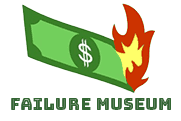Progresso Soup Drops, launched in 2025, combines the flavors of chicken noodle soup in a candy form. They come in a can that resembles the iconic Progresso soup can and include 20 individually wrapped candies, along with a can of actual Progresso Traditional Chicken Noodle Soup. These drops are designed to provide comforting soup flavors in a portable format, making them ideal for cold and flu season.
FoxTrax
FoxTrax, also referred to as the glowing puck, was the first augmented reality system used in sports. The system used modified hockey pucks containing shock sensors and infrared emitters, which were then read by sensors and computer systems to generate on-screen graphics. It was used in Fox Sports’ telecasts of the NHL from 1996 to 1998 at a time when hockey was a low rated sport. However, viewers thought it distracted them from the game.
It was a special effect that tracked every movement of the puck, then superimposed a bluish glow around it for television viewers – all in real-time. When the puck was obscured by a player or by the near boards, the blue glow would highlight where it was. When the puck was passed, a blue comet tail followed it. Most noticeably, when the puck was shot hard, it was followed by a bright red streak, and viewers could easily see the path of the puck if it was deflected or redirected.
McDonald’s Catfish Sandwich
In 1991, the catfish sandwich was McDonald’s intriguing dive into southern cuisine. The 2.3-ounce catfish patty struggled to gain widespread popularity.
Fish McBites
For three months in early 2013, Fish McBites were added to McDonald’s menu, but the public’s response was underwhelming. The meal consisted of fried nuggets of wild-caught Alaskan pollock, a substantial protein source with a mild flavor and delicate texture, and tartar sauce on the side.
Ms Monopoly
In September 2019, Hasbro attempted to make the game of Monopoly more equitable between the sexes. The resulting product was Ms. Monopoly: The First Game Where Women Make More Than Men.
At the start female players get more money than guys—$1,900 versus $1,500—and collect $240 for passing go, rather than the usual $200. The houses and hotels have been replaced by business headquarters in an attempt to step away from the stereotype of women being household bodies.
The property spaces have been replaced with patents that all were invented by women such as chocolate chip cookies, leak-proof diapers, paper shopping bag, the hairbrush, a beauty sponge, and modern shapewear. But, there are plenty of other inventions that would have been much more inspiring to include in a game aimed at children and young adults such as the submarine telescope and lamp, bulletproof vests, and binding material used on modern roofs.
McSpaghetti
McSpaghetti was introduced in the 1970s. The marinara-slathered noodles and optional meatballs were served with a side of garlic bread in a white foam takeout box. McDonald’s had difficulties with sourcing and equipment as well as the public’s annoyance with how long it took to prepare. Spaghetti isn’t exactly viewed as fast food, after all.
McDonald’s Pizza
McPizzas came out in the late ’80s as a family-sized pie. They were eventually reduced to individual-sized pies, but even with the change in measurements, the cook time was still too long for McDonald’s taste.
Pizza took 10 minutes to cook, even with special ovens. That wait time completely clashed with the “fast food” expectation and slowed down drive-thru lines, frustrating both customers and franchisees.
Meanwhile, reviews were mixed about the taste and they were late the the pizza game competing against Domino’s, Pizza Hut, and Little Caesars Pizza.
McDonald’s Onion Nuggets
Launched in 1978 and discontinued in 1979, McDonald’s Onion Nuggets were deep fried chunks of onion, giving them a crispy, golden outer layer. They weren’t a hit for consumers but inspired Chicken McNuggets in 1983.
National Geographic
The rise of the internet and social media has revolutionized the way we consume information. National Geographic, once a trusted source of news and entertainment, is now competing with a myriad of other outlets for our attention.
National Geographic has traditionally focused on natural history and exploration. However, in recent years, the magazine has expanded its scope to include more general interest topics, such as popular culture and current events. This shift in focus has alienated some of National Geographic’s core readership.
National Geographic has been slow to adapt to the changing media landscape. While other magazines have embraced new technologies and platforms, National Geographic has largely remained stuck in the past. This lack of innovation has made it difficult for the magazine to attract and retain new readers.
McDLT
Introduced in the 1980s, temperature was a huge issue when it came to serving the McDLT. McDonald’s wanted to serve the bottom bun and burger patty hot, but also wanted the lettuce and tomato to be cold when the sandwich reached the customer. So, instead of serving the burger wrapped in paper like most of its other offerings, the McDLT arrived in a styrofoam container with two separate compartments — one for the hot ingredients and one for the cold. Of course, this meant there was some assembly required, as the customer would then have to put their burger together themselves before digging in.
The styrofoam containers were necessary to keep the ingredients at the right temperatures — paper would not insulate the hot ingredients and separate them from cold ingredients in the same way — yet they were not great for the environment. Apparently, in the 1990s, environmental activists began criticizing McDonald’s for the amount of styrofoam they were using, and the McDLT was removed from menus to help cut down on the use of non-eco-friendly materials.











